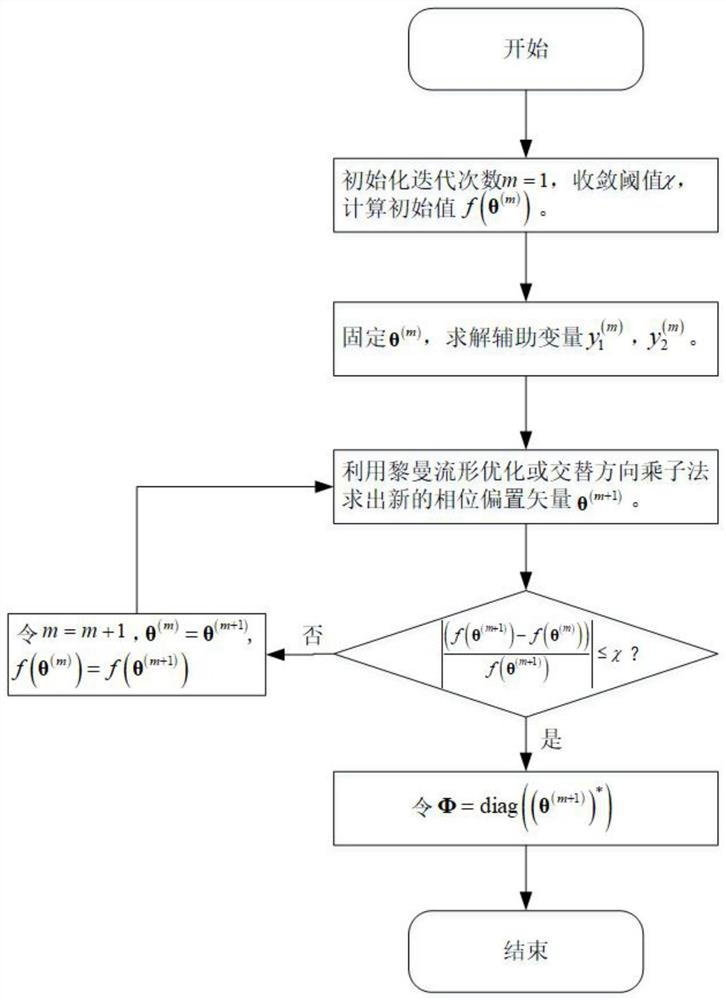MISO system downlink secrecy rate optimization method by means of intelligent reflection surface
A reflective surface, rate optimization technology, applied in transmission systems, radio transmission systems, diversity/multi-antenna systems, etc., can solve problems such as high hardware complexity and cost, high energy consumption, and high complexity
- Summary
- Abstract
- Description
- Claims
- Application Information
AI Technical Summary
Problems solved by technology
Method used
Image
Examples
Embodiment 1
[0101] Step S4.3.1, set iteration times k=0, convergence threshold δ, initial point θ k ∈CCM, where CCM is a complex circular manifold, namely Initial search direction ξ k is the point θ k function f 3 (θ)=θ H Uθ-θ H γ-γ H The negative Riemannian gradient of θ, namely
[0102]function 3 at point θ k The calculation method of the Riemann gradient is as follows:
[0103]
[0104] Among them, ⊙ represents Hadamard product, represents the function f 3 at point θ k The Euclidean gradient at is calculated as follows:
[0105]
[0106] Step S4.3.2, according to the backtracking line search to determine along the direction ξ k The search step size μ k .
[0107] Search step size μ k determined by the backtracking line search algorithm;
[0108] Specifically, first find the smallest positive integer t that satisfies the Armijo-Goldstein condition:
[0109]
[0110] Where auxiliary variable τ>0, α, Then μ k =τα t .
[0111] Step S4.3.3, calculation ...
Embodiment 2
[0122] Step A4.3.1, set the number of iterations n=0, introduce auxiliary variables And the penalty factor κ≥0, the phase optimization problem is transformed into the following optimization problem:
[0123]
[0124] s.t.x = θ
[0125] |θ i |=1,i=1,2,...,N
[0126] Step A4.3.2, give the Lagrangian function of the objective function:
[0127]
[0128] in For the equality constraints |θ r |=1, The Lagrange multiplier of , ψ(θ) is an indicator function, when the unit module constraint is established, the value of ψ(θ) is 0, and when the unit module constraint is not established, the value of ψ(θ) is ∞;
[0129] Step A4.3.3, using the alternate direction multiplier method, update the parameters in the following order until the objective function value converges in step A4.3.1:
[0130]
[0131] Thus we can get θ (m+1) = θ (n+1) ;
[0132] Step A4.3.4, when When, Φ (i) =diag((θ (m+1) ) * );when , let m=m+1, and repeat steps A4.3.2-A4.3.4.
[0133] Step...
PUM
 Login to View More
Login to View More Abstract
Description
Claims
Application Information
 Login to View More
Login to View More - R&D
- Intellectual Property
- Life Sciences
- Materials
- Tech Scout
- Unparalleled Data Quality
- Higher Quality Content
- 60% Fewer Hallucinations
Browse by: Latest US Patents, China's latest patents, Technical Efficacy Thesaurus, Application Domain, Technology Topic, Popular Technical Reports.
© 2025 PatSnap. All rights reserved.Legal|Privacy policy|Modern Slavery Act Transparency Statement|Sitemap|About US| Contact US: help@patsnap.com



